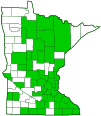American groundnut
(Apios americana)
Conservation • Wetland • Description • Habitat • Ecology • Use • Distribution • Taxonomy
Description |
||
American groundnut is a native climbing vine with attractive flowers and edible beans and tubers. It is native to the United States east of the Great Plains and to adjacent Canadian provinces. It is cultivated as an ornamental in Europe and as a food in Japan and possibly in South Korea. In Minnesota it is common in the southeast and metro regions, uncommon in the central and north-central regions, and mostly absent from the remainder of the state. It is found in bottomland forests and prairies, on banks of streams and rivers, in fens, marshes, fields, and gardens, on roadsides, and in disturbed areas. It grows in wet to moist areas under light shade to full sun in loamy, gravelly, or sandy soil. American groundnut is a perennial vine that rises on multiple stems from a long, creeping, horizontal, underground stem (rhizome) and fibrous roots. Fleshy, thickened areas (tubers), modified for food storage, appear evenly spaced along the rhizome. The tubers are ¾″ to 2″ (2 to 5 cm) long and ⅜″ to ¾″ (1 to 2 cm) wide. It the tuber is separated from the plant it will produce another plant (clone). Plants often fail to produce seedpods, and reproduce mostly by cloning. The stem is slender, round, light green and 3¼′ to 10′ (1 to 3 m) long. It is usually hairless or sparsely hairy, occasionally densely covered with short, fine, appressed hairs, rarely with longer hairs. It does not produce tendrils. It climbs by spiraling clockwise at the tip around the stem of an nearby plant (twining). When broken, the leaves and stem exude a milky sap. The leaves are alternate and pinnately divided into usually 5 or 7 leaflets, sometimes just 3 leaflets. The leaf stalk (petiole) is slender and ⅝″ to 2¾″ (1.5 to 7.0 cm) long. It may be hairless or hairy. At the base of each petiole there is a pair of small appendages (stipules). Each stipule is ⅛″ to ¼″ (4 to 7 mm) long and hair-like. The leaflets are ¾″ to 4″ (2 to 10 cm) long, and ¾″ to 2⅜″ (2 to 6 cm) wide. The leaf blades are egg-shaped or lance-shaped, rounded at the base, and angled or somewhat tapered to a sharp point at the tip. The upper surface is dark green, pinnately veined, and hairless. The lower surface is lighter green and hairless or sparsely to moderately covered with short hairs. The margins are untoothed. The terminal leaflet is on a ⅝″ to 1 3⁄16″ (15 to 30 mm) long leaflet stalk (petiolule) and is symmetric at the base. The lateral leaflets are on 1⁄16″to ⅛″ (2 to 3 mm) long petiolules and are symmetric or only slightly asymmetric at the base. At the base of each petiolule there is a pair of small appendages (stipels). Each stipel is 1⁄32″ to 1⁄16″ (1 to 2 mm) long and inconspicuous. The stipules and stipels are deciduous, dropping off early. The inflorescence is an unbranched cluster (raceme) of several to many flowers rising from leaf axils. The raceme is ¾″ to 2″ (2 to 5 cm) long, often short, dense, and cone-shaped. It is on a hairy, ¾″ to 2″ (2 to 5 cm) long stalk (peduncle). At the base of the raceme there is a 1⁄16″ to ⅛″ (2 to 3 mm) long modified leaf (bract). At the base of each flower there is a 1⁄16″ to ⅛″ (2 to 3 mm) long secondary bract (bractlet). The bracts and bractlets are deciduous, dropping off early. The flowers are about ½″ long. There are 5 outer floral leaves (sepals), 5 petals, 10 stamens, and 1 style. The sepals (collectively the calyx) may be light green or colored like the petals. They are united at the base into a broadly bell-shaped, 1⁄16″ to ⅛″ (2 to 3 mm) long tube then separated into one long and four short lobes. The long lobe is about half as long as the tube. The petals are brownish-red to brownish-purple. They form a butterfly-like corolla, as is typical of plants in the pea family. They are organized into a broad banner petal at the top, two narrow, lateral, wing petals, and between the wings two petals fused into a keel. The banner is strongly concave, broadly notched at the tip, and thickened at the top forming a small hood. The outer surface is usually pale or almost white. The wings are inversely egg-shaped, angled downward, and spreading. The keel is narrow, sickle-shaped, and strongly curved upward. The stamens are equal in length. The stalks (filaments) of nine of the stamens are fused together, the tenth is free. The style is stout and strongly curved or curled. It has a cap-like stigma at the tip. The fruit is a 1 9⁄16″ to 2⅜″ (4 to 6 cm) long, 3⁄16″ to ¼″ (5 to 6 mm) wide seed pod with usually 4 to 6 seeds. It is somewhat flattened and is tapered at the tip. The seeds are dark brown, oblong to almost circular, ⅛″ to 3 ⁄16″ (4 to 5 mm) long, and ⅛″ (3.5 to 4.0 mm) wide. Fresh fruits are edible but only after being cooked. |
||
Height |
||
Climbing: 3¼′ to 10′ (1 to 3 m) long |
||
Flower Color |
||
Brownish-red to brownish-purple |
||
Similar Species |
||
Habitat |
||
Wet to moist. Bottomland forests and prairies, banks of streams and rivers, fens, marshes, fields, gardens, roadsides, and disturbed areas. Light shade to full sun. Loamy, gravelly, or sandy soil. |
||
Ecology |
||
Flowering |
||
July to August |
||
Pests and Diseases |
||
|
||
Use |
||
|
||
Distribution |
||||
|
Sources |
|||
| 2/11/2023 | ||||
Nativity |
||||
Native |
||||
Occurrence |
||||
Common |
||||
Taxonomy |
|||
| Kingdom | Plantae (Plants) | ||
| Division | Tracheophyta (Vascular Plants) | ||
| Subdivision | Spermatophytina (Seed Plants) | ||
| Class | Magnoliopsida (Dicots) | ||
Order |
Fabales (Legumes, Milkworts, and Allies) | ||
Family |
Fabaceae (Legumes) | ||
| Subfamily | Faboideae | ||
| Tribe | Phaseoleae | ||
| Genus | Apios | ||
Subordinate Taxa |
|||
Synonyms |
|||
Apios americana var. turrigera Apios tuberosa Glycine apios |
|||
Common Names |
|||
American groundnut American potato-bean America-hodoimo cinnamon vine ground-bean groundnut hodoimo hopniss Indian potato potato bean wild bean |
|||
Glossary
Axil
The upper angle where a branch, stem, leaf stalk, or vein diverges.
Bract
Modified leaf at the base of a flower stalk, flower cluster, or inflorescence.
Bractlet
A small, often secondary bract within an inflorescence; a bract that is borne on a petiole instead of subtending it; bracteole.
Filament
On plants: The thread-like stalk of a stamen which supports the anther. On Lepidoptera: One of a pair of long, thin, fleshy extensions extending from the thorax, and sometimes also from the abdomen, of a caterpillar.
Peduncle
In angiosperms, the stalk of a single flower or a flower cluster; in club mosses, the stalk of a strobilus or a group of strobili.
Petiole
On plants: The stalk of a leaf blade or a compound leaf that attaches it to the stem. On ants and wasps: The constricted first one or two segments of the rear part of the body.
Petiolule
The stalk of a leaflet blade on a compound leaf.
Pinnate
On a compound leaf, having the leaflets arranged on opposite sides of a common stalk. On a bryophyte, having branches evenly arranged on opposite sides of a stem.
Raceme
An unbranched, elongated inflorescence with stalked flowers. The flowers mature from the bottom up.
Rhizome
A horizontal, usually underground stem. It serves as a reproductive structure, producing roots below and shoots above at the nodes.
Stipel
A small, secondary, stipule-like appendage found at the base of a leaflet stalk.
Tuber
An underground root (as with dahlias) or stem (as with potatoes), thickened by the accumulation of reserved food (usually starch), which serves for food storage and vegetative propagation.
Twining
Growing in a spiral usually around a stem of another plant that serves as support.
Visitor Photos |
|||||
Share your photo of this plant. |
|||||
| This button not working for you? Simply email us at info@MinnesotaSeasons.com. Attach one or more photos and, if you like, a caption. |
|||||
Alfredo Colon |
|||||
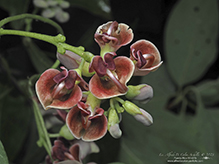 |
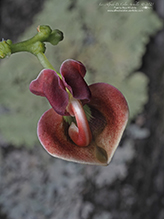 |
||||
Luciearl |
|||||
Found growing on the shore of Gull Lake. |
|||||
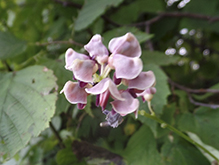 |
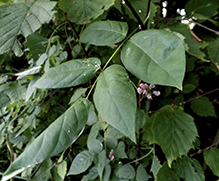 |
||||
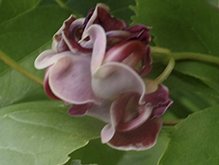 |
|||||
MinnesotaSeasons.com Photos |
|||||
Vine |
|||||
 |
|||||
Flower |
|||||
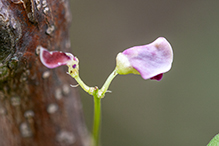 |
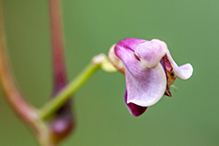 |
||||
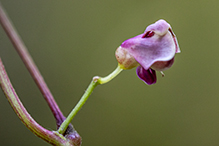 |
|||||
Stem |
|||||
 |
|||||
Leaf |
|||||
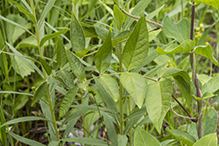 |
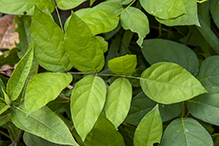 |
||||
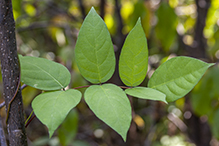 |
 |
||||
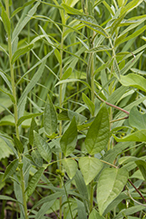 |
|||||

Visitor Videos |
|||
Share your video of this plant. |
|||
| This button not working for you? Simply email us at info@MinnesotaSeasons.com. Attach a video, a YouTube link, or a cloud storage link. |
|||
Other Videos |
|||
| American Groundnut (Apios americana and priceana) Mountain Gardens |
|||
About
Sep 24, 2013 Joe Hollis of Mountain Gardens discusses the American Groundnut. To learn more, visit http://www.mountaingardensherbs.com/ |
|||
| Wild Edibles: Digging up and identifying Apios Americana (Indian Potato) Thrifty Maine Prepper |
|||
About
Sep 7, 2014 My memory card was almost full, so it's a quick vid, but hopefully it helps give people a general idea of what to look for. I am no expert however, so please consult a local expert before eating any wild edibles you find! And just to prove I am not an expert, I actually ended up getting poison ivy (or maybe poison oak), because I was not paying attention to the surrounding plants while I was digging these up. This is on my little bug out island in Maine. |
|||
| Edible Plants: Groundnut Blanche Cybele Derby |
|||
About
Aug 4, 2014 Groundnut aka Hopniss ("Apios americana") is a plant native to North America .Try it instead of, or with, potatoes and other vegetables. |
|||

Visitor Sightings |
|||||
Report a sighting of this plant. |
|||||
| This button not working for you? Simply email us at info@MinnesotaSeasons.com. Be sure to include a location. |
|||||
| Alfredo Colon 8/26/2022 |
Location: Albany, NY |
 |
|||
| Luciearl 8/30/2020 |
Location: Fairview Twp, Cass County Found growing on the shore of Gull Lake. |
 |
|||
MinnesotaSeasons.com Sightings |
|||||

Created: 10/13/2020
Last Updated:
